#Sydney Light Rail
Text

Sydney Light Rail, New South Wales, Australia: The Sydney light rail network is a light rail/tram system serving the city of Sydney, New South Wales, Australia. The network currently consists of three passenger routes, the L1 Dulwich Hill, L2 Randwick and L3 Kingsford lines. Wikipedia
60 notes
·
View notes
Text
Sydney: Wentworth Point & Metro adventures
Following my morning around Circular Quay I hopped on a ferry for the roughly hour-long ride to Wentworth Point. This high density suburb is just beside the Sydney Olympic Park and forms one of Sydney's many 'tower clusters' across the metro area.


There is a 'green bridge' (for pedestrians, cyclists & buses) over to Rhodes, where the main station is. After lunch with a friend, I crossed the bridge to catch one of Sydney's infamous double decker trains to connecting with the Sydney Metro North West at Epping.

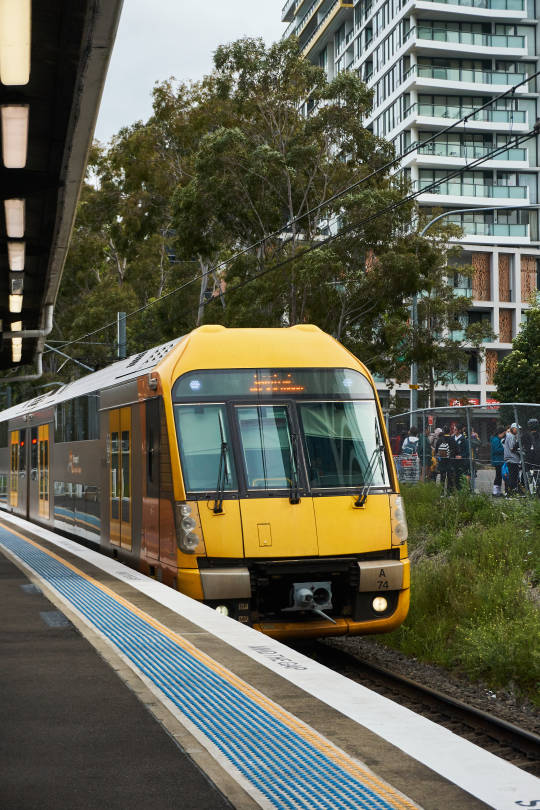

From Epping's underground station I rode to Cherrybrook, which I was hoping would give me a chance to spot one of the Metro trains (the Alstom Metropolis model, like Montréal's new REM trains) out in the open.
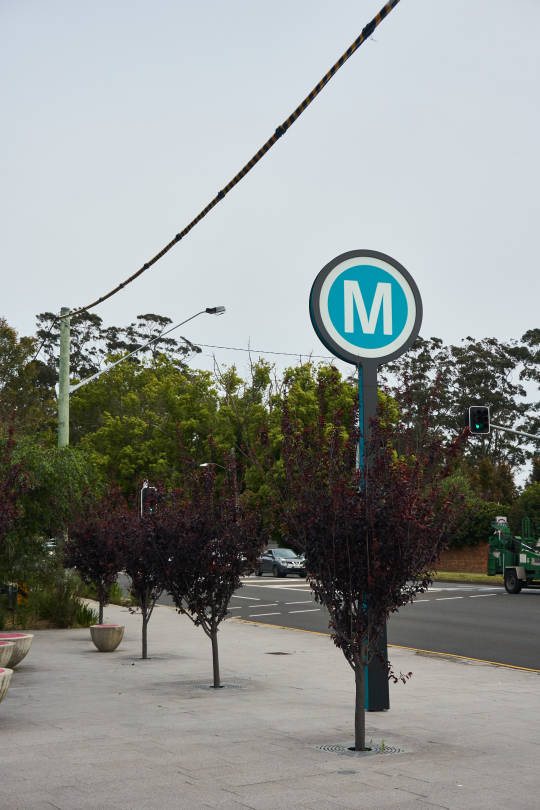

With some difficulty I did manage to get a bit of a glimpse, but this is the downside with a line that's either below ground or on pillars - it is very hard to train spot!
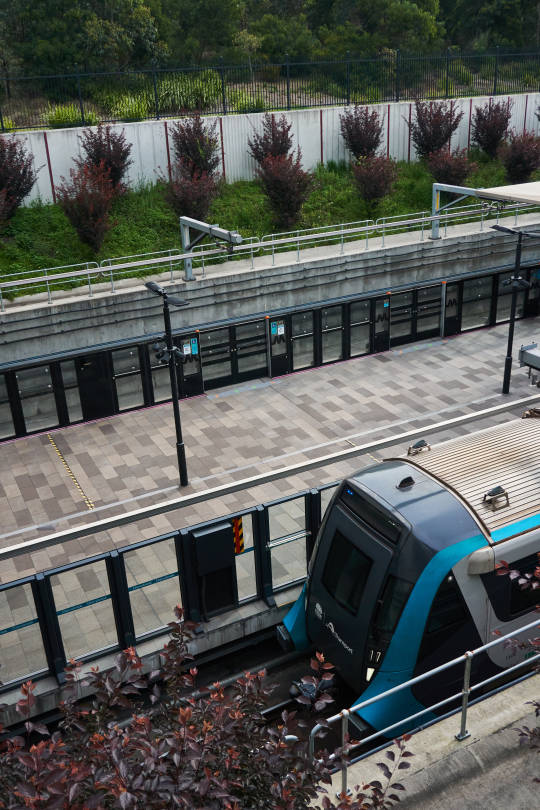
On the way back to Chatswood, I was travelling counter peak and the train was pretty much empty. Which meant I got to enjoy the 'driver's seat' (since these trains are automated). I'll have to head out to ride again to the end of the line to experience the elevated portions.
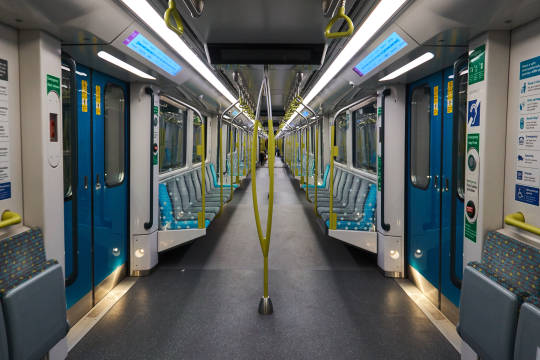
From Chatswood it was an easy transfer to head back into the city, where I walked down George Street to complete my multimodal day with light rail photos.



#syd22#wentworth point#olympic park#epping#rhodes#cherrybrook#sydney metro#sydney trains#sydney#new south wales#sydney light rail#light rail#train#metro#alstom#alstom metropolis#transit#public transport#george street#australia
0 notes
Text
Intelligent signage - LOOK FOR LIGHT RAIL.
Well I found it hurtling east through the newly opened Wimbo Park in Sydney’s Surry Hills.

2 notes
·
View notes
Text
real sydney culture shock is going from central station (space port) to central station (1970s)
#also saw the train to melbourne has been replaced by a bus sucks to suck#why is using a light rail stop as a meeting point feel humbling#i have seen two rails past and my friends aren’t here yet#also got reminded it wa remembrance day by this light rail stop#i forgor#sydney trains#central station
2 notes
·
View notes
Text
In the late 1950s Sydney ripped up its tram network, once one of the largest in the world. Nearly 1,000 trams – some only a few years old – were rolled to the workshops in the city’s eastern suburbs and stripped of anything that could be sold, before being unceremoniously tipped on their sides, doused with sump oil and set ablaze.
Now the trams are returning, as the city painfully rebuilds a tiny part of its old system. The construction of 12.8km of light rail from Circular Quay to Randwick and Kingsford will cost $2.7bn at the latest estimate, has caused untold misery to shops and other businesses in its path and will be almost a year overdue by the time even the first section is open.
The new line hardly represents a fundamental shift in Sydney’s transport thinking, coming as it does alongside the vast “congestion-busting” WestConnex freeway project, and further investment in metro rail (a separate light rail link is also under construction at Parramatta). But it is a reminder that the city might have looked very different today but for the decision taken in the 1950s – and ruthlessly carried out – to prioritise motor transport.
Mathew Hounsell, a senior research consultant at the Institute for Sustainable Futures at the University of Technology, Sydney, has called the destruction of the network “the largest organised vandalism in our nation’s history.”
He says the decisions made in the 50s had a disastrous long-term effect. “When the trams were removed from Sydney, mass transport patronage plummeted and private car usage soared. Our space-saving trams were replaced with ever-more space-hungry cars, causing ever-worsening traffic.”
That wasn’t how the planners saw it at the time. They were strongly swayed by powerful international influences, which chimed with the unstoppable rise of private car ownership in Australia.
As Graeme Davison relates in his book Car Wars, a succession of Australians studied traffic engineering in the US in the 50s, some under a scholarship sponsored by the Myer family, and brought back an evangelical commitment to urban freeways. And, as one engineer from Los Angeles invited to advise on Melbourne’s traffic future put it: “All large American cities that were beating traffic tangles were getting rid of trams.”
youtube
The people of the past seem happier than we, yeah? The fools.
0 notes
Note
Sydney Trains T set
Class of electric train operating in Sydney, Australia
The T sets, also referred to as the Tangara trains, are a class of electric multiple units that currently operate on the Sydney Trains network. Built by A Goninan & Co, the sets entered service between 1988 and 1995, initially under the State Rail Authority and later on CityRail. The T sets were built as "third-generation" trains for Sydney's rail fleet, coinciding with the final withdrawals of the "Red Rattler" sets from service in the late 1980s and early 1990s. The Tangaras were initially built as two classes; the long-distance G sets and the suburban T sets, before being merged after successive refurbishments.
Quick Facts T set, In service ...
Design
Vestibule
The Tangara is a double-deck four-car set, with the two outer cars being driving control trailers (carrying a D prefix) that are fitted with one pantograph each and the middle two cars being non-control motor cars (carrying an N prefix). All sets are equipped with chopper control.
Unlike most other Sydney Trains rolling stock, the seats on the suburban T sets are fixed, meaning that half the seats face backwards. Former G sets, however, do have reversible seats.
History
Initial delivery
In July 1986, the Government of New South Wales awarded A Goninan & Co a contract for 450 carriages. In 1993, it was decided that the last 80 carriages of the order would be built to a modified design to operate peak-hour services to Wyong, Port Kembla and Dapto. In 1996, five spare driving trailers were ordered.
The Tangara name is of Aboriginal origin, meaning to go.
Two subclasses of Tangara were built, the suburban sets targeted as T sets, and outer-suburban sets originally targeted as G sets. The T sets replaced the first generation of Sydney's electric rolling stock.
The G sets differed from the T sets in originally having manual door buttons, high-backed reversible seats, toilets, fresh water dispensers and luggage racks. Additionally, the G sets were delivered with a revised design at the front and rear of the train, notably an angular cutout in the bottom of their noses. Additionally, the pinstriped grey panels below the cab windows were replaced with light orange panels for improved visibility. All T sets have a number plate below a hundred while all G sets are numbered at or above
T sets
G sets
Original liveries
The first train (set T20) was unveiled at Sydney Central in December 1987, heavily promoted as the "train of the 21st century", operating a promotional service on 28 January 1988 targeted as TAN1, and entering regular service on 12 April 1988. The final T set (set T59, formerly T92) was delivered in February 1994 and the final G set (set T100, formerly G32) in October 1995.
The cars built were:
T set driving trailer cars: D6101-D6284 with additional spare cars D6285-D6289
T set non-driving motor cars: N5101-N5284 with additional spare car N5285
G set driving trailer cars: OD6801-OD6840 with additional spare car OD6841
G set non-driving motor cars: ON5801-ON5820
G set non-driving motor cars with toilet: ONL5851-ONL5870
Set G7 was fitted with an AC drive system for evaluation purposes with the existing DC stock and compatibility with signalling and communication systems on the network. G7 was scrapped in 2005 at Maintrain, Auburn after the Waterfall rail accident, as all four cars were beyond repair.
Upgrades in the early 2000s
Original interior
First refurbishment
When first introduced, the T sets were fitted with passenger door release handles to prevent loss of air conditioning at stations. These were later disconnected (and later removed) due to passengers not getting used to opening the doors for themselves when needed. The seats originally had fabric upholstery, but this was gradually replaced by blue vinyl.
In the early 2000s, all Tangaras were updated with a new CityRail corporate appearance. This involved painting the passenger doors and much of the front and rear ends of the trains yellow. Blue and yellow stripes along the bottom of the carriages were replaced by a single yellow stripe and updated CityRail logos were placed on the driving cars.
In late 2005, 15 V set carriages were suddenly withdrawn due to the discovery of corrosion in their underframes. G sets began to operate more off-peak Intercity services to Port Kembla, Kiama, and Wyong to cover for the withdrawn V sets. H sets started entering service in December 2006. The newer trains feature a very similar level of passenger amenity to the G sets and can be seen as a continuation of the design. Their introduction lead to a change in the role of the G sets. From 2007, the G sets were progressively redeployed to suburban services, providing extra capacity on high-demand existing services such as on the Western line and allowing new services to be introduced. By 2008, G sets were often used on peak suburban services that extended into intercity areas, such as services to Springwood (via the Western line).
Conversion of G sets to T sets
A converted G set
In 2009, the conversion of G sets to T sets began, to improve their suitability for suburban working as H sets took over their outer suburban duties. Conversion work consisted of the removal of toilets and their replacement with additional seating. Other work included the installation of new handrails and hangers and the recoding of cars and sets. The carriage numbers were kept, however the O (outer suburban) prefix was dropped. OD became D, while ONL and ON became N. The set numbers were reclassified from G1-30 to T100-130. G4 was the first to be converted (into T104). In 2010, sets being converted started receiving a full interior refurbishment as part of the program to refurbish all the Tangara carriages. In 2018, sets T14 and T121 (ex G21) both became mixtures of T set and ex-G set carriages, with both sets swapping two carriages with each other.
Upgrades in the 2010s
T sets
Ex-G sets
Second refurbishment
In 2010, a refresh of the Tangaras commenced with the interiors repainted, and new seating upholstery and handrails fitted.
In July 2013, Sydney Trains trialled rearranging the seating on the upper and lower decks of two carriages. There were 16 fewer seats per carriage; 3x2 seats were replaced by 2x2 seats in one carriage (N5134 on set T78) while in the other carriage (N5131 on set T77) there are double seats on one side and a bench style seating on the other. Both carriages were later returned to the normal 3x2 arrangement.
In 2014, phase one of a technology upgrade program, aiming to improve reliability and upgrade ageing components, was underway. A contract for phase two of the program, aiming to extend the life of these trains and bring technology into line with newer trains was awarded to UGL Limited in August 2015. This was expected to be completed by July 2018. The expected completion date was revised to 2019, however as of February 2023 only 2 sets have entered service with the second phase upgrades.
The first phase of the program involved upgrading the passenger doors to cut down on vandalism, as the steel panels on the original doors were prone to being kicked out by vandals. The door kicking incidents often led to unnecessary delays as the guard had to lock off the affected carriage. The new lightweight passenger doors have a similar design to the doors on the M sets. This phase of the project was completed at the end of July 2016. The first set to receive the new doors was T96, in October 2014.
The second phase of the program was initially set to include destination indicators and digital voice announcements, which were installed in T72 and T106, were not installed in other sets due to delays and issues with the DVA system. The upgrade still went ahead however, with vestibules given modifications including marked priority seating and Automatic Train Protection (ATP). The first sets with this revised phase 2 upgrade, T52 and T73, re-entered service on 12 November 2021. As of 26 February 2022, sixteen sets have entered service with the upgrade.
The program includes overhauling air conditioning units, Static Inverter upgrades, and modifications to the Driver's desk/cab.
Other anti-vandal improvements included the introduction of 'Mousetrap' sensors. Trialed in 2015, these sensors are able to detect vapors from strong permanent markers and spray paint; triggering an in-built camera feed which is relayed to Sydney Trains staff as well as the Police Transport Command. They were then installed in most converted G sets.
Service
Lines serviced
The Tangaras usually operate on the following lines:
T1 North Shore & Western Line: Emu Plains to City via Parramatta, City to Berowra or Hornsby via Gordon
T4 Eastern Suburbs & Illawarra Line: Bondi Junction to Waterfall & Cronulla via Hurstville & Sutherland
T7 Olympic Park Line: Lidcombe to Olympic Park
T9 Northern Line: Gordon to Hornsby via Strathfield
South Coast Line: Waterfall & Thirroul to Port Kembla
Since 2013, their operation on Sector 2 has ended timetable services with all of them being displaced to Sector 1 since A sets do not operate on that sector.
Incidents
Wentworthville derailment
Driving trailer car D6127 and motor car N5127 were both involved in the Wentworthville train derailment on 27 December 1989, the first major accident involving the Tangara fleet. D6127 was written off, having collided with the platform. N5127 was sent to Dunheved on the Ropes Creek line for training fire fighters, along with S Set car C3866.
Vineyard collision
On 10 February 1994, set T99 travelling from Richmond towards Blacktown collided with a van at the level crossing at Vineyard. The first 3 cars derailed in a zig-zag format, starting a nearby grassfire.
Unanderra derailment
On 24 January 2009 at 2:35 AM, set G4 (now T104) was departing from Unanderra towards Wollongong and derailed due to the train passing a signal at Danger, and the catch-points derailing the train to avoid a collision with a freight train. The first 2 cars and the front bogie of the third car derailed and stopped safely 50 metres from the signal. Subsequently because of this incident, G4 was the first G set to undergo conversion to suburban T set T104.
Carriage pierced by guard rail
During evening peak on 15 January 2014, motor car N5222 on set T10 was pierced by a guard rail near Edgecliff railway station while on a service to Cronulla. Issues with the train were already developing on the previous run, triggering wheelslip sensors on the train multiple times. As the train entered the Eastern Suburbs Line, a strong burning smell was reported at several stations. It was later revealed that an incorrectly repaired axle on N5222 led to the force of the 440-tonne train picking up the piece of guard rail.
Kembla Grange derailment
On 20 October 2021 at 4:09 AM, Tangara set T42 derailed near Kembla Grange station on a level crossing. It was caused by a motor vehicle that was stolen and driven up the rail corridor near the railway crossing. Car D6212 fell onto its side and car N5212 also derailed, while cars N5211 and D6211 did not derail and only had minor damage. There were no serious passenger injuries or deaths as a result of this incident, however two passengers, as well as the guard and the driver, were hospitalised to be checked. The Driver was badly injured during the rollover of the Driver trailer carriage. T sets usually don't operate through Kembla Grange, however due to industrial action on the day of the incident banning the usual H sets, they were used.
4D
4D at Spencer Street
Main article: 4D (train)
A train bearing strong resemblance to a Tangara, known as the 4D, was built by A Goninan & Co in 1991 for the Public Transport Corporation. Although outwardly similar to the Tangaras it was mechanically very different being built to be compatible with the Comeng trains operated in Melbourne. It was included in the sale of Hillside Trains to Connex Melbourne in August 1999. It wasn't successful and after spending large periods out of service, being withdrawn in December 2002 and stored at Newport Workshops. The 4D was bought by CityRail for parts and then scrapped in March 2006 by them at Sims Metal, Brooklyn, Victoria. The G sets' cab ends have a design similar to the 4D, with the bottom part being bent inwards.
Notes
Former G sets are 81.21 m (266 ft 5 in).
Former G set cars are 20,385 mm (66 ft 11 in).
Former G set cars are 53 t (52 long tons; 58 short tons).
Former G set cars are 45 t (44 long tons; 50 short tons).
This person sent the same ask 3 times in a row and I read all three just to make sure they were all the same
yay train facts! I have a fun train fact: they are very yummy to eat 😋
13 notes
·
View notes
Photo
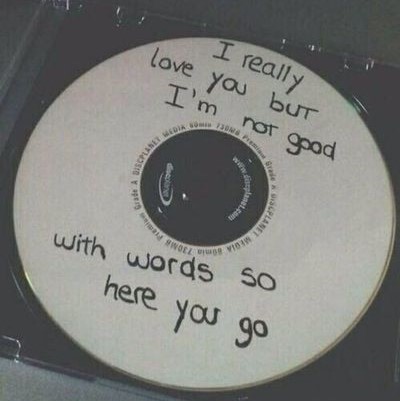


Thiam Playlist - Halsey Specific
Darling - But only you have shown me how to love being alive
1121 - You could have my heart, and I would break it for you
Young God - don't get cut on my edges
I'm the king of everything and oh, my tongue is a weapon
There's a light in the crack that's separating your thighs
Finally / beautiful stranger - And up come my fists
And I say I'm only playing, but
The truth is this
That I've never seen a mouth that I would kill to kiss
Alanis’ Interlude - Bad news, think I'll prolly die before I have you
Soft skin, soft eyes
All these beautiful laps and beautiful thighs
They always kept me up at night
Heaven in Hiding - And when you start to look at me, a physical fatality
Sorry - I run away when things are good
And never really understood
The way you laid your eyes on me
In ways that no one ever could
Ashley (Theo) - Apart from my beatin' heart
It's a muscle, but it's still not strong enough to carry the
Weight of the choices I've made
929 - I've got a long way to go until self-preservation
Think my moral compass is on a vacation
And I can't believe I still feed my fucking temptation
And I'm still looking for my salvation
Graveyard - They say I may be making a mistake
I would've followed all the way, no matter how far
I know when you go down all your darkest roads
I would've followed all the way to the graveyard
I HATE EVERYBODY - But in reality I don't even
Remember anything but thinkin' you're the one
Killing boys (Liam) - Told me pick my battles and be picking 'em wise
But I wanna pick 'em all and I don't want to decide
Is There Somewhere - I'm trying not to let it show, that I don't want to let this go
Is there somewhere you can meet me?
'Cause I clutched your arms like stairway railings
And you clutched my brain and eased my ailing
Haunting - 'Cause I've done some things that I can't speak
And I tried to wash you away, but you just won't leave
So won't you take a breath and dive in deep?
'Cause I came here so you'd come for me
Forever (is a long time) - He cut me open
Sucked the poison from an aging wound
Now fifty thousand war cadets
Would cower at this small brunette
@sydney-winchester and I talked about Halsey lyrics and Thiam and I finally had enough to make a list. I have no idea how to add the actual songs so here we go
56 notes
·
View notes
Note
Do you have any wlw ships?
Do you mean in general or in death note? lol
In death note, i really like to think about Takada x Misa with their fanon version, in which they decide to take down Light together, and, to some extent, even Misa x Rem lol
Generally, though, at the top of my head:
Mio x Eunju (Dice: the cube that changes everything)
Beidou x Ningguang, Lisa x Jean, Ei x Yae Miko, Lumine x Ayaka, Madame Ping x Guizhong, Navia x Clorinde, Kokomi x Kujou Sara, Yelan x Yanfei (Genshin Impact)
Stelle x March 7th, Kafka x Himeko, Qingque x Fu Xuan, Cocolia x Serval, Bronya x Seele (Honkai Star Rail)
Max x Chloe, Chloe x Rachel (Life is Strange)
MC x Jaehee Kang (Mystic Messanger)
Sydney x Dina (I am not okay with this)
Violet x Isabella (Violet Evergarden - fuck Gilbert)
#there are surely some other i am leaving out lol#anyway#thanks for the ask!!#dn.inbox#then of course i have my personal ocs ships but it doesn't matter here lmao
7 notes
·
View notes
Photo
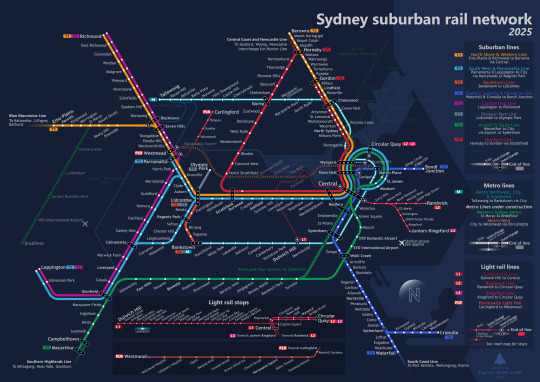
2025 update to my transit map of Sydney! Including the soon-to-open Metro and Light Rail lines, as well as some rumoured service pattern changes to T9 and T8.
#auscore#transit maps#transit diagrams#Sydney#sydney trains#sydney metro#crossing's art#nsw#cityrail
17 notes
·
View notes
Note
actually you know what I can’t stop thinking about?? I left Sydney in 2011 when the airport line still ended at east hills. it now is the main line to Melbourne and Canberra. now there are three TRAMS in the east and inner west and a metro tunnel train thingo through the hills out to tallawong? parramatta is properly becoming the cbd it always deserved to be (kind of). whatever the fuck is being developed at emu plains?? there’s almost an airport there now?? there’s a pretty new development at bangaroo? (I can’t even remember what used to be there). and then there’s whatever they’re digging for at rozelle?? the city tends to move on all the same it is so sooo trippy and if I’d spent the last 12 years buzzing around the world and barely registering my surroundings and didn’t happen to be from the one suburb that’s remained the same as it was in 2010 as well as have a brain filled with urban design lore I would actually find it rather disconcerting
sydney waits for no one. BUT SERIOUSLY WHAT WAS AT BARANGAROO BEFORE?? i literally do not have a clue. but western sydney airport is good news i hope. and the metro!! and the light rail!! i love sydney public transport (despite its tendency to fail)
3 notes
·
View notes
Photo




Through the Years → Mary, Crown Princess of Denmark (749/∞)
28 April 2023 | Denmark's Crown Princess Mary speaks with Sydney Lord Mayor Clover Moore following a tour of the light rail in Sydney. (Photo by Steven Saphore/AFP via Getty Images)
6 notes
·
View notes
Text
Sydney: Barangaroo to Town Hall

It was fascinating to see Barangaroo have some actual life to it this time after visiting for years and it just being a dull mix of construction and half empty towers.


The passageway to Wynyard Station remains my favourite part of this area, but there is also some interesting architecture and public art appearing!
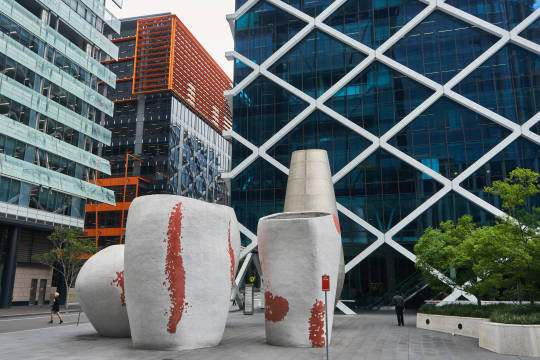
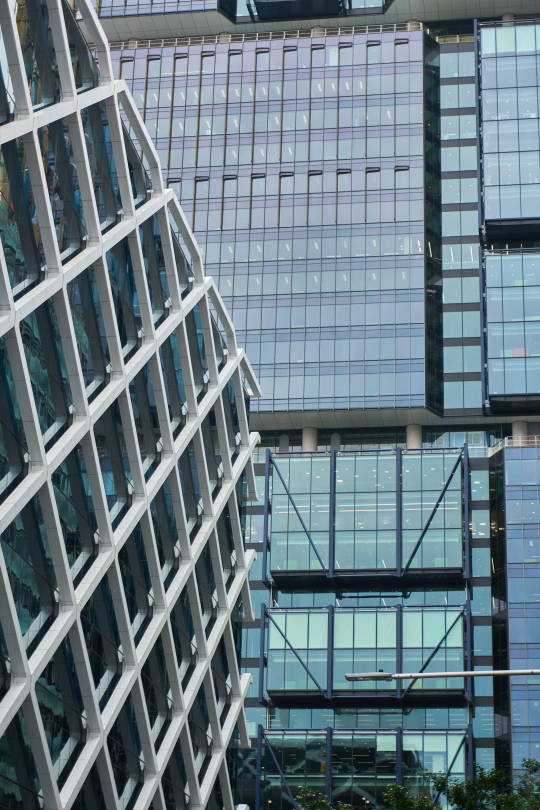
After walking through Barangaroo north to south, I headed east back towards Town Hall on George Street and a bus home.
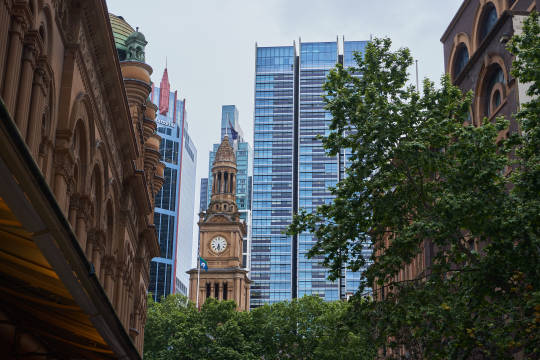
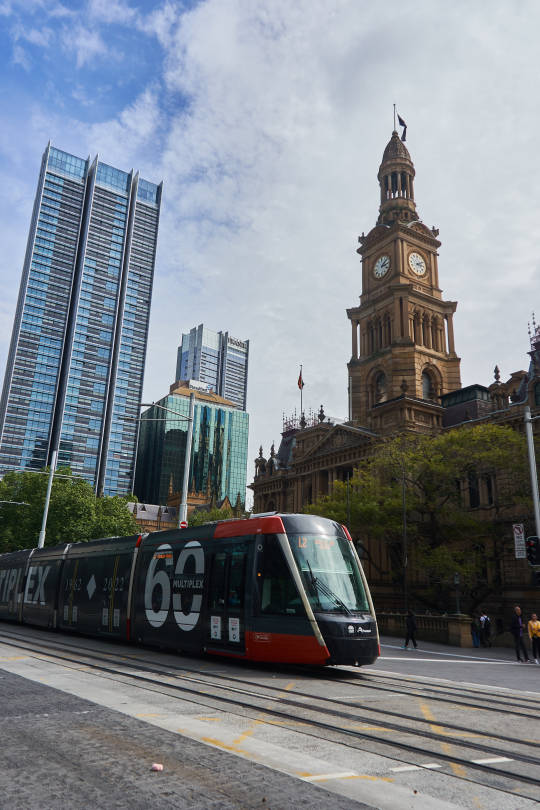



[13 October 2022]
#syd22#sydney#barangaroo#george street#tram#light rail#town hall#qvb#city centre#urbanism#new south wales#australia
1 note
·
View note
Text
Outside the trains don’t run on time.
He believes it’s no coincidence.
Gang of Four, 1979.
Light rail on Devonshire Street, Surry Hills, Sydney, 2023.

5 notes
·
View notes
Text
if i got a dollar for every time i jaywalked George street I’d be rich
1 note
·
View note
Text
A-60/Daniel's Death. (Lore for my Rooms AU)
It was night at the office, at room A-60, was Daniel standing by the rails of the metal bridge above, smoking his cigarette.
He slowly puffed out smoke from his mouth, making a cough sound after smoking his cigarette. He just feels uneasy at the moment since he hasn't heard Sydney or Andrew at the moment.
He just shrugs it off and continues to smoke his cigarette.
Then he heard thumping coming from the other side, he turned his head around. " Hey. Y'know you aren't supposed to be here at night. " He said, looking a bit annoyed.
But nobody was there, he got confused when he heard thumping noises behind him. Behind him when he turned around was someone lighting a lighter on his hand.
When Daniel turned, he immediately got lit on fire on his hair, spreading to his face, screaming in pain while this was happening.
Then the person hold a gun by his other pocket, shooting him in the head.
He fell on the ground still one fire, a hole in his head which was bleeding on the floor.
Guess that was all the victims in this office now.
4 notes
·
View notes
Note
Sydney Trains K set
Class of electric train operating in Sydney, Australia
The Sydney Trains K sets are a class of electric multiple units that currently operate on the Sydney Trains network. Built by A Goninan & Co, the K sets first entered service in 1981 operating under the State Rail Authority, and later CityRail. The carriages are of stainless steel, double deck construction and share much of their design with the older S sets. All of the 40 K sets originally built (160 carriages) remain in service and are currently the oldest in the Sydney Trains fleet.
Quick Facts K set, In service ...
K set
K81 departing Summer Hill station
Refurbished vestibule
In service
1981–present
Manufacturer
A Goninan & Co
Built at
Broadmeadow
Constructed
1981–1985
Refurbished
late 1990s
Number built
160 carriages
Number in service
160 carriages
Successor
Converted H sets
Formation
4-car sets
Fleet numbers
C3501–C3580
D4096–D4099
T4171–T4246
K60–K99 (full 4-car sets)
Capacity
452 (108 in power cars, 118 in trailers)
Operators
Sydney Trains
Depots
Flemington
Lines served
Inner West & Leppington
Bankstown
Airport & South
Specifications
Train length
81.54 m (267 ft 6+1⁄4 in)
Car length
20,385 mm (66 ft 10+1⁄2 in)
Width
3,036 mm (9 ft 11+1⁄2 in)
Height
4,368 mm (14 ft 4 in)
Doors
Sliding pocket, 2 per side
Maximum speed
115 km/h (71 mph)
Weight
188 t (185 long tons; 207 short tons)
Traction system
Mitsubishi camshaft resistance control
Traction motors
4 × Mitsubishi 150 kW (201 hp) series wound DC motor
Power output
1.2 MW (1,609 hp)
Electric system(s)
1,500 V DC (nominal) from overhead catenary
Current collector(s)
Pantograph
UIC classification
Bo′Bo′+2′2′+2′2′+Bo′Bo′
Track gauge
1,435 mm (4 ft 8+1⁄2 in) standard gauge
Close
Design and construction
The K sets were the first New South Wales suburban trains to be air conditioned and have headlights.
Two orders were placed for the K sets with all manufactured between 1981 and 1985 by A Goninan & Co in Broadmeadow:
Order 1
More information Qty, Class ...
Qty Class Carriage numbers Notes
50 Power cars C3501–C3550
4 Driving trailers D4096–D4099 converted to trailer cars 2014
46 Trailer cars T4171–T4216
Close
Order 2
More information Qty, Class ...
Qty Class Carriage numbers
30 Power cars C3551–C3580
30 Trailer cars T4217–T4246
Close
A K set in its original State Rail Authority livery in the 1980s. Some sets were originally classified as R sets.
The first order featured low mounted upper deck windows, off-white and sagebrush grey interiors, and unpainted fronts. The second order featured higher mounted upper deck windows, yellow and mustard interiors and State Rail Authority candy livery fronts. The first four trailers were built as driving trailers allowing them to operate in two-car formation, although in practice they were formed into four carriage sets and often ran together as one eight-car set until 1988. These also differed in the subsequent deliveries in being fitted with air conditioning from new, rather than pressure ventilation. To provide a spare, C3550 & T4216 were also built with air conditioning. All ten carriages were fitted with different windows, being sheet glass with small opening hoppers. This was replaced with sheet glass in 1993.
To accommodate the air conditioning and associated equipment, the pantograph had to be shifted to the adjacent trailer car to which the power car is semi-permanently coupled with high voltage cables connecting the two cars. Although some power cars and trailers have been broken up and married with others during periods of heavy maintenance, many original combinations remain.
The control carriages have a flat front, with headlights at the top. They were built with four sets of marker lights, standard at the time. Different combinations of white marker lights were used to indicate different destinations. Flip-dot destination displays were installed later on, which covered the upper middle marker light. Since destination displays have been installed, marker light combinations are no longer necessary, so usually only the two upper marker lights are used. However, some trains still retain the switch for the lower marker light. The front of the train also has an emergency door for the guard compartment and windscreen wipers for the driver window only. Hoses and receptacles are provided below the windows to connect another set, since, unlike newer trains, the coupler does not carry electrical or air connections.
Like other trains of the time, the crew compartment contains a smaller compartment for the driver on the left side (in direction of travel). The guard uses the area outside of the driver's compartment, with two manual hinged doors on either side providing access to platforms. Above these doors, on the outside are blue lights indicating which compartment the guard is in.
Each vestibule has two-panel sliding doors on either side. Each door also has a vent underneath the window, which was covered when air-conditioning was installed. The doors cannot detect obstacles and continue pushing against the obstruction until it is removed or the guard reopens the doors. Small orange LEDs are located above the doors on the outside that flash when the doors are closing. They assist the guard in locating doors that haven't closed successfully. All trains were retrofitted with traction interlocking, meaning the driver cannot apply power when the doors are open.
In service
All K sets are crewed with a driver and guard. The guard uses the rear cab on a two or four-car train. On eight car trains, the guard usually uses the 5th carriage so that the entire platform can be seen. However the 4th carriage cab can also be used if there is a problem with the 5th carriage one.
All the K sets were delivered to either Hornsby or Punchbowl depots. With the trials on the ten experimental carriages judged successful, in 1986 a programme commenced to retrofit air conditioning to the second order. This saw the Beclawat windows replaced with sheet glass. It would be July 1990 before the programme was completed.
In April 1989, K sets commenced operating peak-hour services via the North Shore line to Gosford. This was extended to Wyong in January 1992. In September 1990, all Punchbowl based sets were transferred to Hornsby.
In January 1991, four sets were transferred to Flemington Maintenance Depot to operate peak-hour Illawarra line services to Port Kembla.
To replace U sets on stopping services between Gosford and Newcastle, the sets with driving trailers were re-marshaled as two-car sets from October 1996.
Following the delivery of the outer suburban Tangara sets in 1994, the K sets ceased operating the Central Coast and Illawarra services.
Upper deck after the CityDecker refurbishment of the 1990s.
During the late 1990s, all were refurbished by A Goninan & Co as part of the CityDecker program. This saw the interiors refurbished with white walls and ceilings, grey floors and blue seats. Power cars received a destination indicator and had yellow applied to the lower half of their fronts. Sliding Beclawat windows on the pressure ventilated cars were replaced with hopper windows and doors painted yellow. The first order was finally retrofitted with air conditioning just prior to the Sydney 2000 Olympics. These cars retained the hopper windows until the late 2000s, but were sealed shut with an adhesive to avoid the loss of air conditioning.
After the introduction of a new timetable in October 2009, all K sets were allocated to Hornsby to operate North Shore, Northern & Western line services, operating in 8-car formations. This was due to the noise levels inside trains when operating on the Epping to Chatswood segment. Older S sets lack sufficient sound insulation for passengers, while newer Tangara sets don't have sufficient cooling in the dynamic braking system to deal with extended shuttle runs through the tunnel.
In mid-2014, K sets are gradually transferred from Hornsby to Flemington resulting in their resumption of service on the Airport, Inner West & South, Bankstown, Carlingford and Olympic Park lines. K60 to K86 were previously running these lines, based out of Flemington Depot. Prior to 2017, K87–99 continued to run part-time on the T1 North Shore, Northern & Western lines.
In October 2013, the 2 car K Sets (K1–4) were withdrawn from NSW TrainLink Gosford to Newcastle services. The four driving trailers were converted to ordinary trailers at Hornsby and the sets returned to service on Sydney Trains services in March 2014 as K98 and K99. The existing K98 was re-numbered K91. The driver cabins in these carriages were stripped of controls however the actual walls were kept intact. The doors to the driver cabin are kept locked and the blinds are kept down. There are no passenger seats where the crew compartment used to be. Also, unlike converted S set cars, the round window on the crew compartment doors were removed and covered with a metal plate.
In July 2017, asbestos was found in the circuit breaker panels, which is inside the driver compartment of the K sets, with all withdrawn for inspection for a few weeks. All have since returned to service.
After the introduction of a new timetable in November 2017, all K sets were transferred to Sector 2.
In late 2017 and early 2018, all K sets and C sets were slightly refurbished with all poles and other safety features repainted yellow.
In 2019, set K96 was withdrawn from passenger service and had Automatic Train Protection (ATP) equipment installed. It has conducted ATP testing since then and will be retained following the retirement of the rest of the fleet for this purpose.
K sets operate on the following lines:
T2 Inner West & Leppington Line: Leppington or Parramatta to City Circle via Granville
T3 Bankstown Line: Liverpool or Lidcombe to City Circle via Bankstown
T8 Airport and South Line: Macarthur to City Circle via Airport or Sydenham
They were formerly in operation on the T6 Carlingford line until it was closed in January 2020.
Preservation
While at the moment there are no developed plans for the preservation of any K set cars, Sydney Electric Train Society has expressed interest in preserving at least one. K96 will likely be retained for the purposes of ATP testing after the K sets are withdrawn from revenue service.
Several heritage tours have used K sets prior to retirement, these have been:
-the girl who sent the k set wiki
Damn I'm doing some sick train studying today thanks for the facts and history! /gen
4 notes
·
View notes